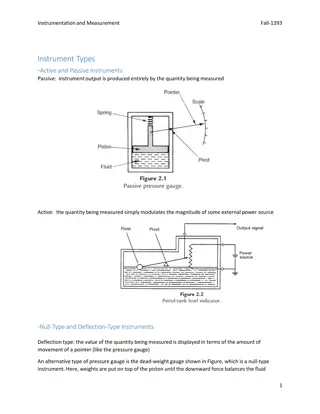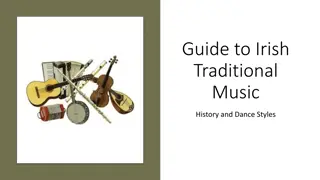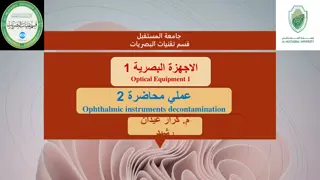
Surgical Instruments Overview: Scalpels, Forceps, and Nomenclature
Learn about surgical instruments like scalpels and forceps, their functionality, nomenclature patterns, and the importance of choosing the right tools for medical procedures. Discover the significance of handles on medical scalpels and the different types of forceps available for various surgical tasks.
Download Presentation

Please find below an Image/Link to download the presentation.
The content on the website is provided AS IS for your information and personal use only. It may not be sold, licensed, or shared on other websites without obtaining consent from the author. If you encounter any issues during the download, it is possible that the publisher has removed the file from their server.
You are allowed to download the files provided on this website for personal or commercial use, subject to the condition that they are used lawfully. All files are the property of their respective owners.
The content on the website is provided AS IS for your information and personal use only. It may not be sold, licensed, or shared on other websites without obtaining consent from the author.
E N D
Presentation Transcript
OT INSTRUMENTS MS. REVATHY. A
A surgical instrument is a tool or device for performing specific actions or carrying out desired effects during a surgery or operation, such as modifying biological tissue, or to provide access for viewing it. Some surgical instruments are designed for general use in all sorts of surgeries, while others are designed for only certain specialties or specific procedures.
The nomenclature of surgical instruments follows certain patterns, such as a description of the action it performs (scalpel, hemostat), the name of its inventor(s) (the Kocher forceps), or a compound scientific name related to the kind of surgery ( a tracheotome is a tool used to perform a tracheotomy).
1. Scalpel A scalpel, lancet, or bistoury, is a small and extremely sharp bladed instrument used for surgery, anatomical dissection, podiatry. Surgical scalpels consist of two parts, a blade and a handle. The handles are often reusable, with the blades being replaceable. In medical applications, each blade is only used once (sometimes just for a single, small cut).
The handle of medical scalpels come in several basic types. Blades are manufactured with a corresponding fitment size so that they fit on onaly one size handle.
2. Forceps Forceps are a handheld, hinged instrument used for grasping and holding objects. Forceps are used when fingers are too large to grasp small objects or when many objects needed to be held at one time while the hands are used to perform a task. Surgical forceps are commonly made of high-grade carbon steel, which ensures they can withstand repeated sterilization in high-temperature autoclaves.
They are made of other high-quality stainless steel, chromium and vanadium alloys to ensure durability of edges and freedom from rust. The invention of surgical forceps is attributed to Stephen Hales. There are two basic types of forceps: non-locking (often called "thumb forceps" or "pick-ups") and locking, though these two types come in dozens of specialized forms for various uses.
A) Thumb forceps Thumb forceps, known simply as forceps in surgical specialties, are commonly held in a pen grip between the thumb and index finger (sometimes also the middle finger). Spring tension at the top end holds the grasping ends apart until pressure is applied.
This provides an extended pinch and allows the user to easily grasp, manipulate and quickly release small objects or delicate tissue with readily variable pressure. Thumb forceps are used to hold tissue still when applying sutures, to gently move tissues out of the way during exploratory surgery and to access confined cavities that are hard to reach with hands and fingers
Thumb forceps can have smooth tips, cross-hatched tips or serrated tips (often called "mouse's teeth"). Serrated forceps are used on tissue; counter-intuitively, teeth will damage tissue less than a smooth surface because one can grasp with less overall pressure. Smooth or cross-hatched forceps are used to move dressings, remove sutures and similar tasks.
B) Locking forceps Locking forceps, sometimes called clamps, are used to grasp and firmly hold objects or body tissues, or to apply external compression onto tubular structures such as blood vessels or guts. When they are specifically used to occlude an artery to forestall bleeding, they are called hemostats. Another form of locking forceps is the needle holder, used to guide a suturing needle through tissue.
Many locking forceps use finger rings/loops to facilitate handling. The finger loops are usually grasped by the thumb and middle or ring fingers, while the index finger helps stabilize and guide the instrument.
a. Artery Forceps It is the main and essential instruments in the surgical instrument tray. The main uses of artery forceps for controlling bleeding and for the retraction of tissues, skin, etc. Artery forceps are otherwise called as Haemostatic forceps. The hemostat used to blocks the flow of blood and tips close the blood vessels. Its also used to hold the tissue and skin.
b) Mosquito Forceps Mosquito artery Forceps are used as a hemostat for blood vessels. Used to hold delicate tissues. Used in most of surgical cases.
c) Allis Forceps An Allis clamp (also called the Allis forceps) is a commonly used surgical instrument. It was invented by Oscar Allis. The Allis clamp is a surgical instrument with sharp teeth, used to hold or grasp heavy tissue. It is also used to grasp fascia and soft tissues such as breast or bowel tissue. Allis clamps can cause damage, so they are often used in tissue about to be removed. When used to grasp the cervix to stabilize the uterus, such as when an intrauterine device is being inserted, an Allis clamp has the advantage of causing less bleeding than the more commonly used tenaculum.
d) Kockers Forceps Kocher Forceps contain 1x2 teeth on straight or curved jaws to avoid slippage when trying to grip arteries. This hemostatic forceps is typically used for general surgeries, it may also be applied to more specific procedures such as of the gallbladder or removal of the thyroid.
Helps to hold ribs during rib resection. To rupture the gestational membrane.
e) Babcock Forceps Babcock forceps are one of the most recognized surgical instruments and continue to be widely used by surgeons today. As atraumatic tissue forceps, they allow the surgeon to manipulate bowel and are often used in bowel anastomosis and cardiothoracic procedures. They are helpful in grasping delicate tissue.
Helps to hold intestine, fallopian tube, ovaries ,appendix etc.
f) Sponge-holding Forceps Sponge forceps, also known as sponge holding forceps, are used for holding swabs or sponges in medical procedures. The jaws themselves are normally rounded. Elongated tips may be included for delicate operations. Medical sponge forceps allow minor surgical operations to be performed without excessive trauma or damage.
g) Needle Holder A needle holder, also called needle driver or needle forceps, is a surgical instrument similar to a hemostat, used by doctors and surgeons to hold and push a suturing needle when performing wound closure, ligation and other surgical procedures that require re-anastomosis.
A retractor is a surgical instrument used to separate and manipulate the edges of a surgical incision or wound, or to hold back underlying organs and tissues so that body parts underneath may be accessed. The broad term retractor typically describes a simple steel tool possessing a curved, hooked, or angled blade, which when in place helps to maintain the desired position of a given region of tissue during surgery.
Retractors can also be "self-retaining," and not need to be held once inserted, having two or more opposing blades or hooks which are separated via spring, ratchet, worm gear or other method. The term retractor is also used to describe distinct, hand-cranked devices such as rib spreaders (also known as thoracic retractors, or distractors) with which surgeons may forcefully drive tissues apart to obtain exposure. Different surgery specialties can have specific kinds of retractors
1. Hand Retractors - (Manual) must be held by an assistant, a robot or the surgeon during a procedure. Categories 2. Self Retaining Retractors - (Stay open on their own) have a screw, ratchet or some type of clamp to hold the tissue by itself. These allow the surgeon with two free hands. .
A) Langenbeck Retractor Langenbeck Retractor is a very popular surgical device that allows surgeons to pull back soft tissues and incision or wound edges during a wide range of general surgeries. Versatile L-Shaped tip for retracting wide slices of tissue. Terminal downward curve for protecting surrounding structures.
B) Doyens Retractor Mainly used in abdominal OB/GYN procedures like procedures for ectopic pregnancies, abdominal hysterectomies, cesarean section deliveries Available in stainless steel material finish As a gynecological instrument, it is specifically made to be used in pelvic operations
Used to hold organs back while surgery is being conducted Coming in passivated, ultrasonic cleaned and dull-polished finish Provides for left hand/right-hand usage Also used by surgeons to either actively separate edges of the surgical incision or wound
C) Kelly Retractor Kelly Retractors are used for deep exposure. The retractors have a long flat blade and a finger ring handle for a secure grip. This retractor is commonly used to pull back, or retract, the edges of wounds in order to expose the surgical area.
E) Devers Retractor Used to retract deep abdominal or chest incisions. Used in Cholecystectomy (removal of gallbladder) for retraction of right lobe of liver. Used in Truncal vagotomy (division of the main trunk of the vagus nerve) for retraction of left lobe of liver.
F) Morris Retractor Used while making and closing abdominal incisions for ease of working in the deeper layers. Used to retract Pectoralis major in MRM for better visualization during axillary dissection.






















